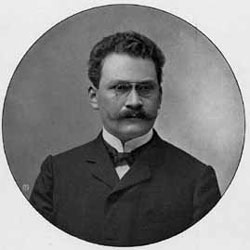Momentum From Nothing
Nothing will come of nothing, avers Shakespeare’s King Lear, but don’t tell that to physicists. An object in strong electric and magnetic fields can siphon momentum out of the vacuum of empty space and begin to move, one researcher predicts in the 16 January PRL. The strange effect should be observable in the laboratory with current technologies.
The vacuum of empty space is a restless place. According to quantum mechanics, particles pop in and out of existence, and those “virtual” particles give the vacuum energy and can affect tiny objects. For example, two parallel metal plates will feel a minute force, called the Casimir effect, pulling them together. That’s because virtual photons with certain wavelengths cannot exist between them. The vacuum outside the plates thus has more energy, so it squeezes the plates together.
But the vacuum can also possess momentum, says Alexander Feigel of Rockefeller University in New York, and it should be possible to transfer some of that momentum to a material object. To reach that conclusion, Feigel began by addressing a long-standing controversy in electrodynamics: How should one define the momentum of an electromagnetic field permeating matter? For nearly a century, physicists have had two definitions, one proposed by German physicist Max Abraham and another derived by German mathematician Hermann Minkowski. According to Abraham’s formulation, the momentum of the electromagnetic field should be smaller in materials through which light travels more slowly; Minkowski’s formulation states that in such materials the momentum should be bigger. Using relativity, Feigel found that the Abraham definition accounts for the momentum of the electric and magnetic fields alone, while the Minkowski definition also takes into account the momentum of the material.
Feigel next used his theoretical tools to analyze the momentum inside a material placed in strong, perpendicular electric and magnetic fields. He found that virtual photons traveling through the material would have a strange asymmetry. If the electric field pointed up and the magnetic field pointed north, then virtual photons of a given energy traveling east would have a different momentum from those traveling west. That asymmetry would give the vacuum a net momentum in one direction, and the material would have to gain momentum in the opposite direction to compensate. In fields of 100,000 volts per meter and 17 tesla–which can be created in the lab–the material should move at a rate of 50 nanometers per second, Feigel says, which should be measurable.
Others had reached similar conclusions about the meanings of the Abraham and Minkowski definitions of momentum, but Feigel’s analysis is simpler, says Rodney Loudon of the University of Essex in Colchester, United Kingdom. “He’s done it in quite a nice, elegant way,” Loudon says. However, Ulf Leonhardt of the University of St. Andrews in Scotland says Feigel’s approach may be a little too simple, as it treats the material as a macroscopic object and does not begin with the forces on the individual atoms in it. “There are definitely some subtleties that he’s left out,” Leonhardt says, though the results may still be correct.
Both Leonhardt and Loudon warn that the predicted effect may be difficult to spot. For example, Loudon says, if the material contains a few freely moving electrical charges, they will experience larger forces that may obscure the subtle quantum effect. Still, Leonhardt says, “This is a smart idea.”
–Adrian Cho
Adrian Cho is a freelance science writer in Grosse Pointe Woods, Michigan.



